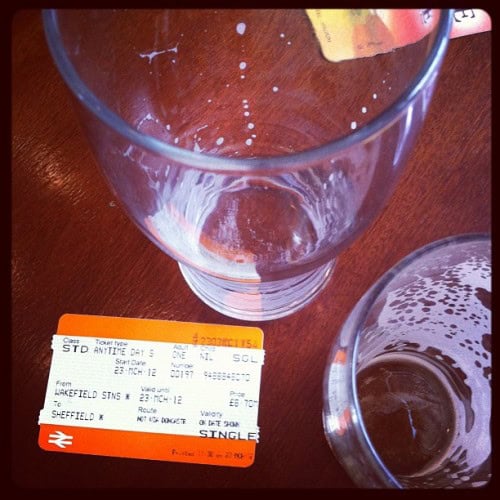This year we’re making a concerted effort to cast our net far and wide and take in the digital scene from Liverpool to Leeds, Newcastle, Manchester, Birmingham and everything in between. Leanne Buchan has ventured south to explore Sheffield’s digital arts festival.
A quick glance at the programme for the Lovebytes festival revealed events with names like ‘Mega Dork’ and ‘Digital Spring’. Here’s a festival that didn’t take itself too seriously, so I leafed through my diary and found a day to take a closer look. It was Friday which arguably wasn’t the best day to visit given that Saturday had ‘Unquiet in the Library’ – where you can be noisy, in a library. The idea of gigs in libraries appealed to the rebellious little child in me but Friday was all I had, so Friday it was.

Myself and my companion, for I couldn’t venture south unaccompanied, eventually made it beyond the Sheffield Tap and into The Showroom Cinema for our first event: Intuition & Ingenuity: The Impact of Alan Turing on Art. We heard from artists Sue Gollifer, Anna Dimitriu, Gordana Novakic, Ernest Edmunds and, my personal favourite, Alex May, as they explained their previous work and latest projects inspired by the legendary Alan Turing.
If like me you’re a philistine, you won’t know that Alan Turing was arguably the father of computer science (it seems the mother of computer science was tad a promiscuous so we can’t be sure); that he invented the world’s first computer which created complex algorithms, which in turn were used to break the Enigma; that his work was shrouded in the secrecy act allowing some American fella to take credit for creating the computer (they were a little bitter about this at LoveBytes); that he was gay when it was still illegal and was chemically castrated as punishment to avoid prison and continue pushing the boundaries of technology. But he did all of these things, and that’s why he’s important enough to have new digital artworks created in his honour.
The talks explored each artist’s approach to Turing and what inspired them. They ranged from geometry and pattern making created using digital algorithms, to the most poignant being a flight announcement screen announcing the penalties for homosexuality that still exist in countries around the world. I say that my favourite was Alex May mainly because of his portfolio of work including 3D light installations on 1960s blocky structures. What I really liked though, was his honesty. Here’s a guy that likes lasers and sticking them to things with duct tape to make great works of art. Simple, really.
We had a quick snack and an obligatory Guinness then returned to the cinema for a screening of Press Pause Play. This was the highlight for me, not least because I didn’t expect it to be. A friend once gave me a copy of Helvetica and told me it would be interesting and that I’d love it. It was not. I did not. He is no longer a friend.
So I went into the screening with little apprehension but it was actually one of the best documentaries I’ve seen in a while. The film covers the development of digital technology and the impact of it on ‘art’, be that music, product design, film making or visual art. The film was balanced from those who had a rose tinted view of what it was like to work with ‘real artists’ who didn’t need to have their voices electronically enhanced, to the new kids on the block who couldn’t quite belive that someone like them was able to be a part of this brave new world.
Press Pause Play raised some interesting ideas about the future of digital art. The most interesting question it raised for me was whether or not technology and the digital age heralded the death of ‘art’. The film put forward a compelling case that in an age of user-generated content everyone is an artist from someone uploading their musical masterpiece to My Space, to those directors in waiting making use of YouTube to reach audiences and film producers world wide. Everyone, apparently, is out there being an artist, but who controls the quality and how do you find real talent in a saturated market?
The other side of the fence was those who were doing great work and took their profession seriously. They were self-taught and ambitious. They weren’t just using the technology at their disposal they were creating it and pushing the industry forward. No they weren’t part of an elite and wealthy set of content editors controlling a fiercely guarded share of the market. But they were bloody good at what they did and made no apology for it.
In the end I decided that technology did not kill art, it simply spread it wider and enabled everyone to have a share in it whether they wanted to label it art or not.
Sadly this was the extent of my adventure south and it left me wanting much more of Sheffield and of LoveBytes, a small but perfectly formed digital arts festival that programmed interesting events, talks, screenings and workshops.
We like this a lot! ;-))
thx, hope to c u next time x
Glad you liked it. I really would like to find out more about Sheffield, don’t suppose you fancy taking me on a tour of the most digital places in the city for a photo blog?